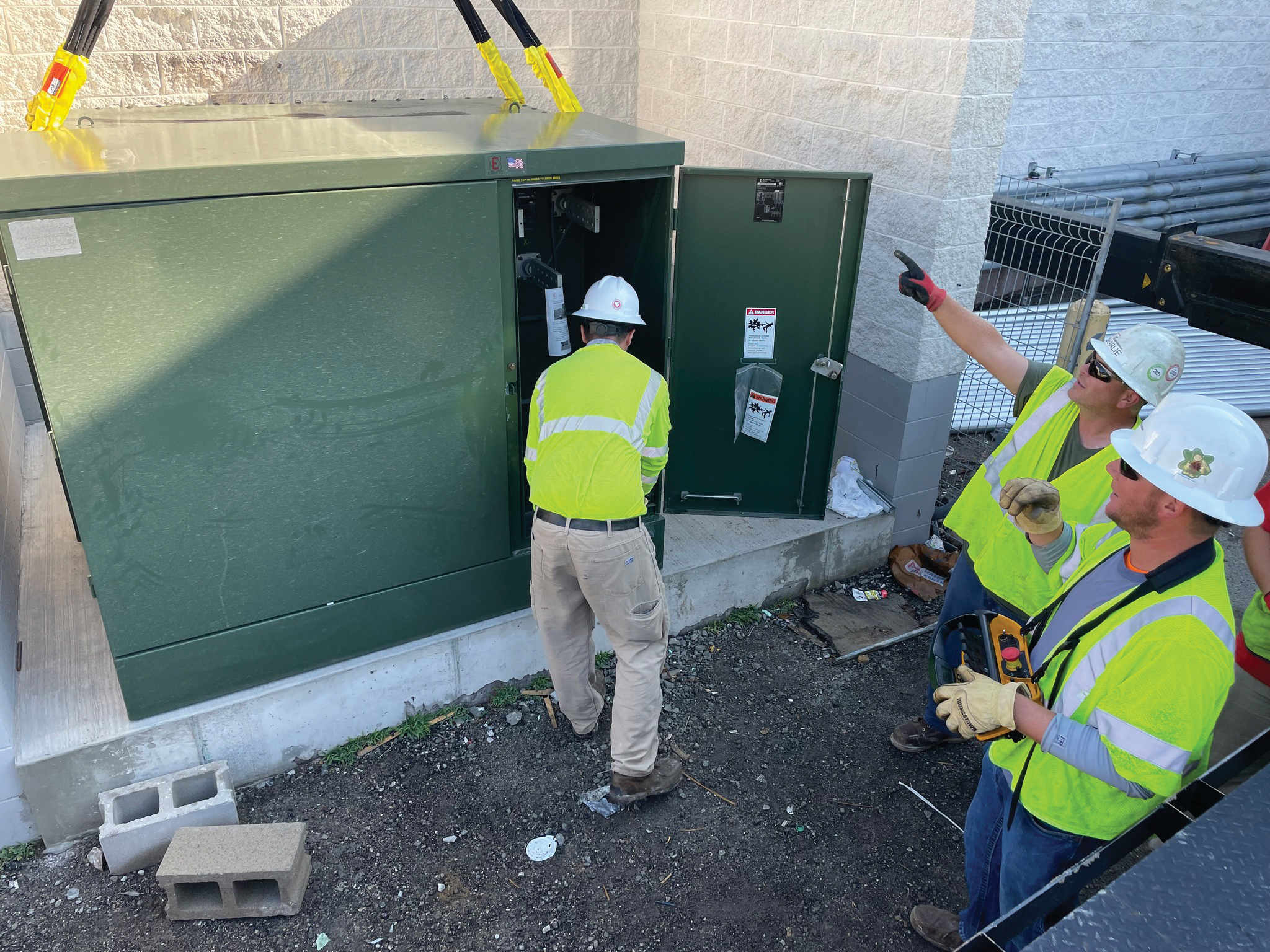
Kentucky’s economy, security and even the health and safety of our population depend on the reliable delivery of water, gas, electricity and internet connectivity.
Recently, Kentucky’s major utilities have risen to the challenge of working with public, private and government partners as the state rides a crest of record economic development.
As population growth and business expansions push existing infrastructure to do more than it was originally designed to do, Kentucky’s utilities are modernizing through the use of cutting-edge technologies to make their networks, systems and grids work smarter and with an eye on cleaner sources of energy.
Heading off reliability issues
East Kentucky Power Cooperative (EKPC) is in the midst of a multi-phase effort to update electric transmission infrastructure to ensure long-term reliability. EKPC expects to spend over $400 million to rebuild about 335 miles of high-voltage transmission lines by 2031.
“We recognize that poles, wires and other equipment are built to last many years, but some are approaching the ends of their useful lives,” said Denver York, EKPC’s senior vice president of power delivery and system operations. “We want to update equipment and infrastructure before it leads to reliability issues for our members.”
EKPC owns and operates about 2,900 miles of high-voltage transmission lines, as well as nearly 400 electric substations.
Kentucky’s Touchstone Energy Cooperatives continue their efforts to bring investment and new jobs to rural communities of Kentucky. Touchstone is comprised of 17 not-for-profit, member-owned electric cooperatives who use electricity provided by EKPC to power the lives of 1.1 million people in Kentucky, along with thousands of factories, warehouses, hospitals, schools, office complexes and shopping malls.
In the past year, the electric cooperatives have worked with local, state and federal officials to highlight sites in Kentucky and help to bring $2.9 billion in new industrial investment, along with over 2,000 new jobs, to the communities served by the co-ops. For the second year in a row, Kentucky’s Touchstone Energy Cooperatives were named among the top U.S. utilities in economic development by Site Selection magazine.
Kentucky’s Touchstone Energy Cooperatives have revamped their economic development website, DataisPower.org, to highlight the group’s online site-selection tools like PowerVision and PowerMap, which puts critical information about Kentucky’s industrial sites at the fingertips of anyone in the world. The website also profiles Kentucky’s newest megasite for industrial development in Rockcastle County, which is 1,111 acres adjoining the community of Spiro and U.S. 150.
“Our role is to tell the story of Kentucky’s rural communities to site selectors around the nation and around the globe, highlighting the many resources our commonwealth has to offer, and helping to bring together the key decision-makers on the local, state and federal levels,” said Brad Thomas, economic development manager for Kentucky’s Touchstone Energy Cooperatives.
Balancing king coal’s future
“Coal has served us well for decades and we will continue to be the largest purchaser of coal in Kentucky, but we are pleased that with approval from the Kentucky Public Service Commission, we will have a more balanced energy portfolio in the future,” said John Crockett, president of Louisville Gas and Electric Co. and Kentucky Utilities Co. (LG&E and KU).
The commission in early November approved the retirement of two aging coal generation units, a new natural gas combined-cycle generating unit, more than 1,000 megawatts of solar energy and battery storage, and one of the largest energy efficiency portfolios in the history of LG&E and KU.

“Natural gas generation will allow us to take a measured approach to our transition and is consistent with our goal of reaching net zero by 2050 without burdening customers and industries with unnecessarily higher costs of energy,” Crockett said.
Natural gas emits 65% less carbon than coal and provides a least-cost, dependable source of generation that can be called upon 24/7 to meet customers’ energy needs day and night. In addition, the approval of nearly 1,000 megawatts of solar and battery storage is an important step in the clean energy transition at LG&E and KU.
LG&E and KU serve more than 1.3 million customers across 90 counties. LG&E serves 333,000 natural gas and 429,000 electric customers in Louisville and 16 surrounding counties. KU serves 566,000 electric customers in 77 Kentucky counties and five counties in Virginia.
Specifically, the order approves one of the two approximately 640-megawatt natural gas combined-cycle units; building a 120-megawatt solar array in Mercer County and acquiring another in Marion County; a 125-megawatt battery storage unit and 14 new energy efficiency offerings. The utilities also are authorized, subject to certain conditions, to secure four power purchase agreements for additional solar generation in excess of 600 megawatts and to retire two coal units, Mill Creek 1 and 2, totaling 600 megawatts and three small natural gas turbines.
Isolating faults and quickly restoring service
This year Kentucky Power has been improving the distribution grid in Martin and Pike counties by adding DACR, Distribution Automation Circuit Reconfiguration, to the distributions circuits to isolate faults and restore service within moments to customers served by the affected circuit. Also, most new distribution line construction is being designed and constructed to the National Electric Safety Code (NESC) heavy loading grade, which is above the grade required.
In late November, Kentucky Power added capacity in the South Shore area of Greenup County that enhances the distribution grid and adds capacity availability in the area for business growth.
The power company is also working on a DACR project in Leslie County that should be in service in early 2024. This project will upgrade an existing obsolete Distribution Automation (DA) scheme with upgraded devices and communications to improve the reliability of the system.
Kentucky Power, headquartered in Ashland, provides service to approximately 163,000 customers in all or part of 20 eastern Kentucky counties. Kentucky Power’s distribution operations work from service centers in Ashland, Hazard and Pikeville and from area offices in Paintsville and Whitesburg.
Dajcor Aluminum in Hazard is an example of how Kentucky Power is constantly looking for ways to help customers expand their operations and attract new customers to relocate in eastern Kentucky.
Dajcor, which is located at the Coal Fields Industrial Park, is utilizing Kentucky Power’s Economic Development Rider, which helps encourage economic development in eastern Kentucky by providing limited-term reductions in billing demand charges. Kentucky Power had multiple people on-site to meet with them before they ever decided to locate here, showing them the existing infrastructure and answering questions and concerns.
The company now employs approximately 100 workers and is running a peak load in excess of 1 megawatt with plans to expand their operations and create even more jobs.
In Ashland, Camp Landing has experienced a complete overhaul and economic development boom over the last few years. Kentucky Power has played a key part in working with new owners and customers inside the renovated Kyova Mall to re-work existing services and install new transformers to accommodate the increased loads.
When the mall was sold to new owners in July 2021, the peak load was under 500 kilowatts. Now with the recent opening of Sandy’s Gaming Facility, that peak load stands at over 3 megawatts.
 Ultraviolet water treatment disinfection
Ultraviolet water treatment disinfection
In 2023, Kentucky American Water continued its efforts to upgrade water infrastructure to support current and future customers. This included replacing approximately 13 miles of water main in the company’s water distribution system. The company plans to continue its efforts to replace aging water mains in 2024, subject to Kentucky Public Service Commission approval.
Kentucky American Water, a subsidiary of American Water that is headquartered in Lexington, provides water and/or wastewater services to customers in portions of 14 counties: Bourbon, Clark, Fayette, Franklin, Gallatin, Grant, Harrison, Jackson, Jessamine, Nicholas, Owen, Rockcastle, Scott and Woodford.
Also among the company’s recent capital investment efforts in 2023 are projects at two of its three water treatment plants—the Kentucky River Station II in Owen County and Richmond Road Station in Lexington—to prepare for upcoming requirements by the U.S. Environmental Protection Agency for enhanced surface water treatment to address cryptosporidium and other viruses. The projects involve incorporating ultraviolet disinfection into existing water treatment processes, for a total investment of approximately $7 million. The Kentucky River Station II project is scheduled to be in service by the end of 2023, with the Richmond Road Station project scheduled to be in service by the summer of 2024.
Swimming robots in your water main
“One of the Louisville Water’s highlights for 2024 will be finishing a four-year project to upgrade nearly 300,000 water meters for customers in Louisville,” said Kelley Dearing Smith, vice president of communications and marketing for Louisville Water. “The new technology will give customers real-time access to their water usage through the Pure Connect portal.”
The largest part of the 2024 capital budget is for infrastructure, including the water mains, pumping stations and treatment plants to ensure reliable service. Louisville Water will continue to inspect and replace water mains while installing miles of new water main to deliver additional drinking water to Nelson and Hardin counties. Water providers in these counties purchase drinking water from Louisville Water as the growth in the Interstate 65 corridor with the Ford Blue Oval project and bourbon distilleries drives the need.
Louisville Water Co. is looking ahead with a focus on technology, infrastructure and affordability. They supply over 120 million gallons of drinking water daily to communities in Louisville Metro and parts of Bullitt, Hardin, Nelson, Oldham, Shelby, Spencer, and Meade counties through 4,200 miles of water mains and systems of tanks and pumps.
For more than 10 years, Louisville Water has used robotic technology to inspect its larger water mains, often while the pipes are filled with water. Recently a device called PipeDiver moved through three and a half miles of a large water main in southern Jefferson County, checking the pipe’s condition. The pipe delivers water to customers in the Highview area of southern Jefferson County and in Bullitt County.
The inspection is part of Louisville Water’s ongoing efforts to proactively check the conditions of the underground infrastructure to prevent issues and avoid leaks and breaks. In 2023, Louisville Water is spending a total of $40 million to inspect, replace and repair infrastructure.
Since Louisville Water started using robotic technology to inspect large pipes, the devices have checked more than 110 miles of water mains and crews have repaired around 250 sections of pipe. Louisville Water has a similar program for the smaller water mains.



















